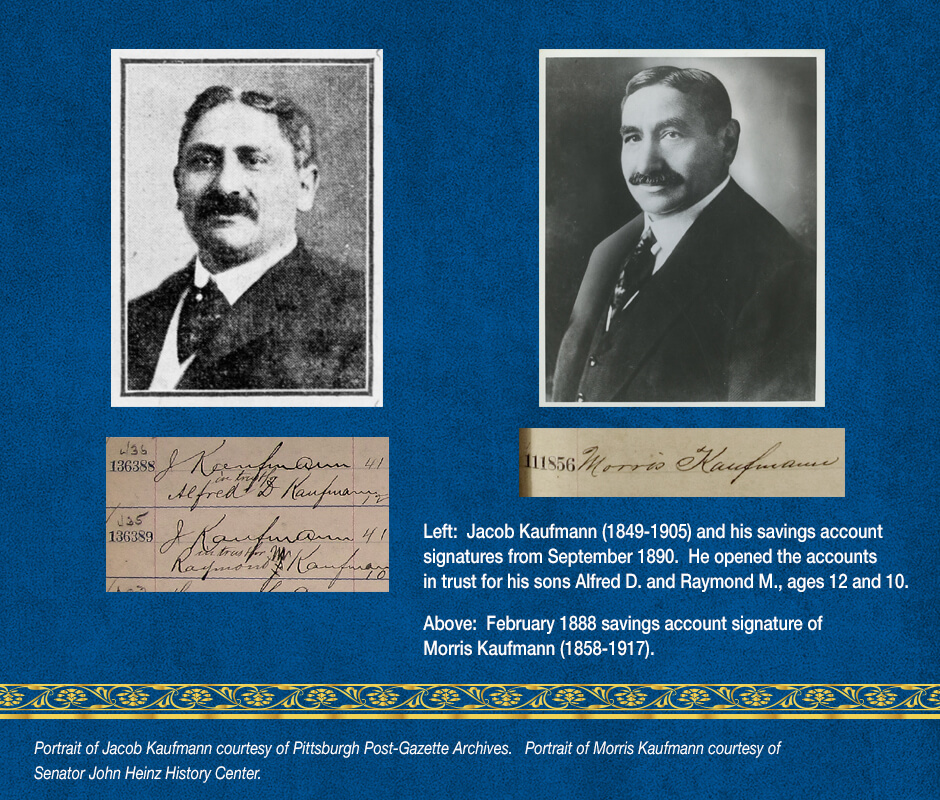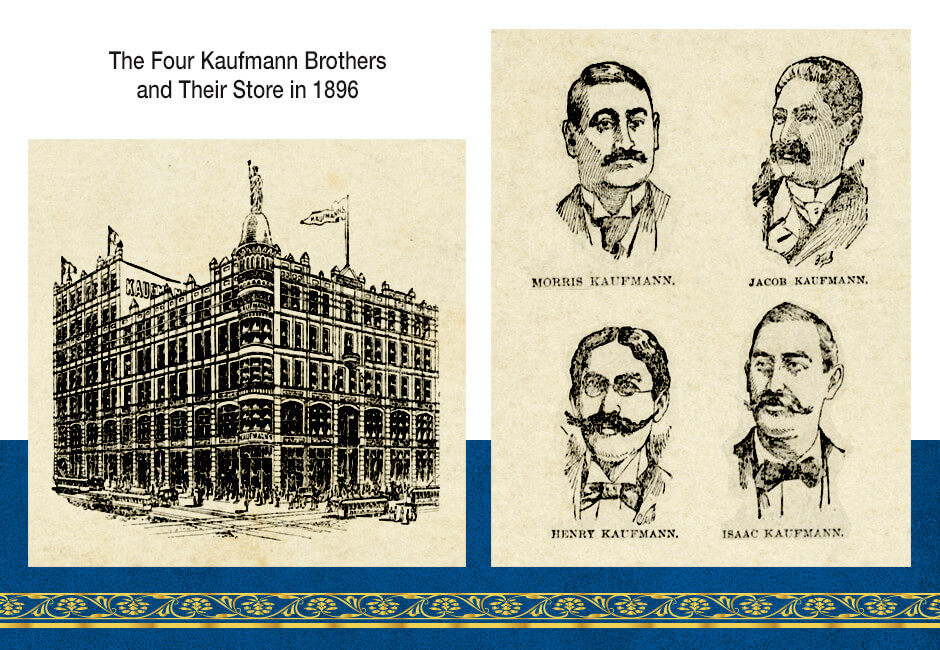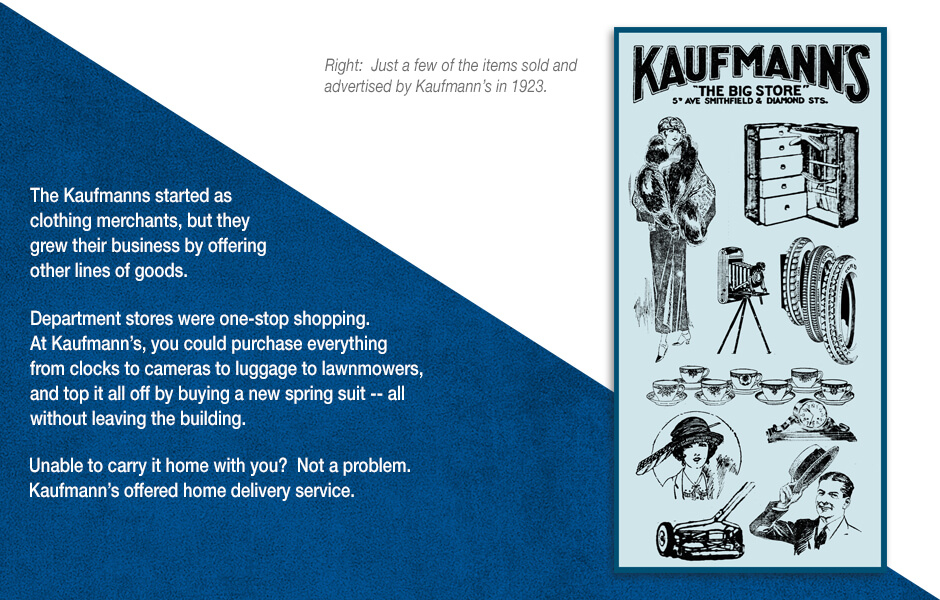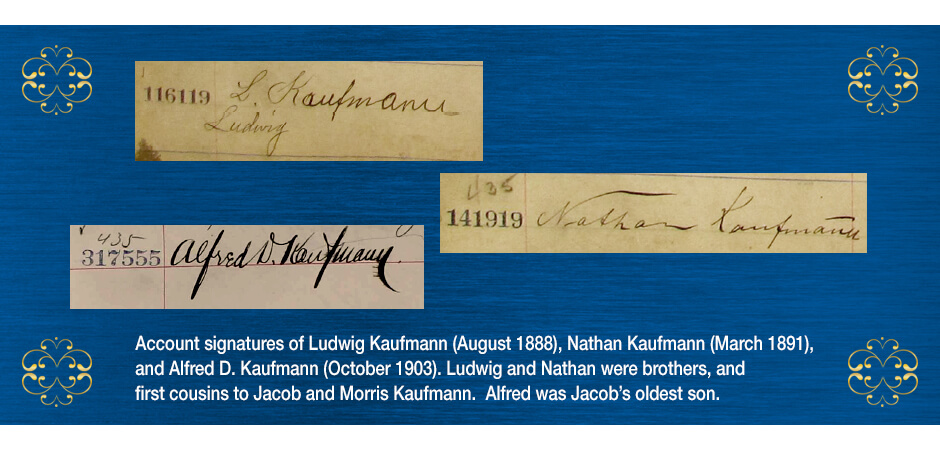The Kaufmann Family

The Making of a Retail Legend: Kaufmann's Department Store
Kaufmann's Department Store had its roots in a retail enterprise run by four brothers who immigrated to Pittsburgh from Viernheim, Germany. First to arrive was Jacob Kaufmann in 1868. Brother Isaac followed the next year. In 1871, the two opened a tailoring and men's clothing store, J. Kaufmann & Brother, on Carson Street on Pittsburgh's South Side.
In 1872, Morris joined his brothers at the shop's new location, also on Carson Street. Henry Kaufmann, the youngest of the four brothers, arrived in the United States in 1876.
As their business thrived, the Kaufmann brothers made plans to move into Downtown Pittsburgh. They opened Kaufmann's Cheapest Corner, their largest store to date, at the corner of Diamond (Forbes) and Smithfield Streets in 1879. In 1885, the Kaufmann brothers unveiled the Grand Depot, a majestic structure at the corner of Smithfield Street and Fifth Avenue.
The Kaufmanns celebrated 25 years in Pittsburgh retail in 1896. Their store was worth more than $2 million, had 56 departments and employed 1,200 people.
Throughout the early 1900s, the Kaufmanns acquired various properties downtown along Smithfield Street and Fifth Avenue. The downtown location became known as "The Big Store," and the acquisition of adjacent properties provided room for expansion.
The Kaufmanns' investments in real estate were extensive. They bought property in several regions of the city, not just downtown. In the East End, they were among the early investors in the transformation of Squirrel Hill from farmland to a residential neighborhood. They were also some of Squirrel Hill's initial 20th-century residents. Jacob's eldest son, Alfred D. Kaufmann, became a real estate broker. He opened a savings account with Dollar Bank in 1903.
Jacob Kaufmann passed away unexpectedly in 1905 at age 56. Two years later, Henry left the family business when his only daughter, Irene, died. In her memory, he founded the Irene Kaufmann Settlement, a social services institution located in Pittsburgh's Hill District. Henry Kaufmann remained at the forefront of philanthropic giving for the rest of his life, one of the most visible members of a family substantially involved in charitable contributions.
Kaufmann's incorporated in January 1913 as the Kaufmann Department Stores, Inc. Isaac was named president, Morris one of two vice presidents, and Morris' eldest son, Edgar Jonas (E.J.), served as secretary and treasurer. The store was now a mammoth company with nearly 4,000 employees, 700,000 square feet of retail space and tangible assets of more than $3 million.
E.J. Kaufmann became heir to the business. Under E.J., Kaufmann's bloomed into a marvel of modern merchandising. His vision was to make the store not merely a center of commerce, but also a mecca of design and culture. He brought his love of art and architecture to Pittsburghers shopping in the family store.

E.J. and his wife, Liliane Kaufmann, were the patrons of two masterpieces of residential architecture: Fallingwater, designed by Frank Lloyd Wright, in Western Pennsylvania, and the Kaufmann Desert House, designed by Richard Neutra, in Palm Springs, California. Both houses reflected the Kaufmanns' sophisticated tastes and admiration for the natural environment, with each residence carefully designed to connect with and showcase the surrounding landscape.
Cousins and Business Rivals
The Pittsburgh Kaufmanns were an extended family which included cousins to Jacob, Isaac, Morris and Henry Kaufmann. As various cousins and in-laws arrived in America from Germany, Kaufmann relatives got jobs at the department store, working their way up through the company and contributing to its growth.
When Ludwig Kaufmann (1871-1957) opened his savings account at Dollar Bank in 1888, he listed his occupation as salesman. He lived at 116 Sheffield Street in Allegheny City. Starting out as a stock boy in the women's apparel department at Kaufmann's, he eventually became the head of the department.
Nathan Kaufmann (1873-1938) was just 17 when, in 1891, he opened his account at Dollar Bank. He lived with his first cousin Morris Kaufmann at 149 Sheffield Street and was working as a stock clerk at Kaufmann's.
When the original Kaufmann's store was incorporated in 1913, Morris and E.J. gained a controlling interest in the business. Seven cousins, who included Ludwig and Nathan, did not receive as great an interest in the corporation as they felt they had earned.
The Kaufmann cousins at that point decided to start their own store. With them they took decades of experience -- Ludwig, 25 years of employment at Kaufmann's, and Nathan, 24 years. Cousin Morris Baer, who had invested 33 years working for Kaufmann's, rising from errand boy and elevator operator to the store's advertising guru and, ultimately, general manager, became president of the new store, which was named Kaufmann & Baer. Ludwig and Nathan's brother, Theodore, was vice president.

Kaufmann & Baer's 17 acres of selling space and 3,000 employees made it one of the largest stores between Philadelphia and Chicago. Like the original Kauffman's, K&B's owners made the store more than a shopping locale. The auditorium at Kaufmann & Baer hosted civic meetings, cooking demonstrations, beauty shows, even a babies' health conference. In December 1922, Kaufmann & Baer, in partnership with the Pittsburgh Press, installed a radio broadcasting station on the store's premises. Not coincidentally, the store sold radio receiver sets, positioning itself in advertising as "the radio store of Pittsburgh."
Hard-working Morris Baer died in March 1919, and Theodore Kaufmann succeeded him as president. In December 1925, Theodore Kaufmann announced that Kaufmann & Baer had been acquired by Gimbel Brothers, Inc., of New York, at that time the largest retail organization of its kind in the world.
In 1928, Ludwig Kaufmann co-founded Kaufmann-Looby Co., a women's boutique, on Penn Avenue. The other half of the store name came from Frances Looby, former head buyer for Kaufmann & Baer, whose glamorous but demanding job entailed being paid to shop all over Europe. Featuring fashions fresh off the runways of Paris, Milan, London and New York, Kaufmann-Looby Co. was adorned with French salons on each of its five floors. It even had its own exclusive perfume scent, created in Europe.
Nathan Kaufmann retired from business shortly after the sale of Kaufmann & Baer to Gimbels. Mr. Kaufmann and his wife, Selma Joseph Kaufmann, lived on Darlington Road in Squirrel Hill before moving to the Dithridge Apartments in Oakland.
